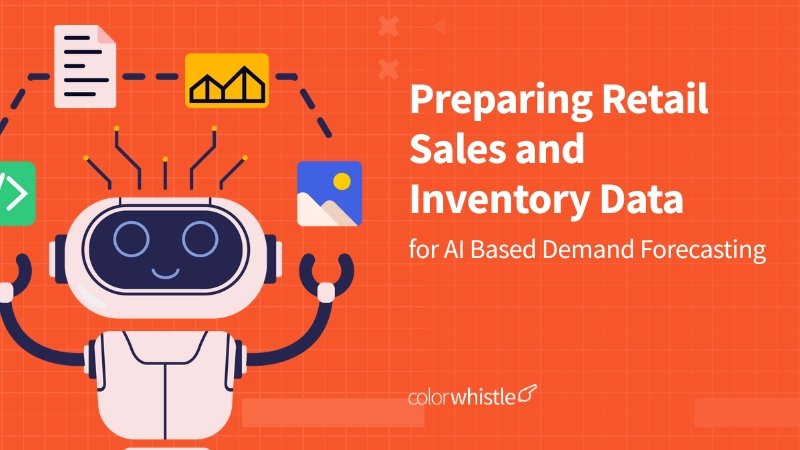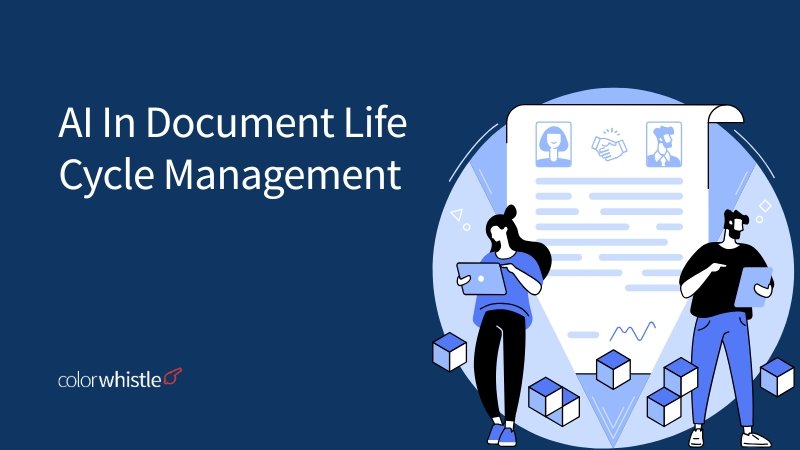Preparing Retail Sales and Inventory Data for AI-Based Demand Forecasting is a critical step for retailers seeking to optimize their inventory management and operational efficiency. Effective data preparation ensures that AI models can generate accurate predictions, leading to better decision-making and improved customer satisfaction.
Importance of data preparation for AI-based demand forecasting in retail.
Accuracy: High-quality data is essential for the accuracy of AI models. Clean, comprehensive, and well-structured datasets enable precise demand forecasts.
Efficiency: Properly prepared data streamlines the forecasting process, reducing the time and resources needed to generate reliable forecasts.
Scalability: Prepared data supports scalable AI solutions, accommodating varying levels of complexity across multiple retail locations and product lines.
Overview of the process:
- Data Collection and Integration: Gather sales and inventory data from various sources such as POS systems, ERP platforms, and online marketplaces. Integrate these datasets into a unified system.
- Data Cleaning and Preprocessing: Remove duplicates, correct errors, handle missing values, and normalize data formats to ensure consistency and accuracy.
- Feature Engineering: Extract relevant features from raw data to enhance the predictive power of AI algorithms.
- Handling Complex Demand Patterns: Address challenges like the bullwhip effect and anomalies by implementing advanced detection techniques.
- Model Selection and Training: Choose appropriate AI algorithms and train them on historical data enhanced with engineered features.
- Validation and Continuous Improvement: Regularly validate forecast outputs against actual sales figures to ensure ongoing accuracy.
By meticulously preparing retail sales and inventory data for AI-based demand forecasting, retailers can significantly improve their operational outcomes, driving cost reductions and enhancing customer experiences.
To further enhance these outcomes, partnering with a reputable firm offering AI app development services can provide access to advanced technologies that streamline these processes even more.
Understanding Key Retail Concepts
Role of Point of Sale (POS) Data in Demand Forecasting
Point of Sale (POS) data is a critical component in demand forecasting for retail. It captures transaction details at the moment of purchase, providing real-time insights into customer buying behavior. This data includes information such as:
- Product sold
- Quantity
- Price
- Time and date of transaction
By analyzing POS data, retailers can identify trends and patterns in consumer demand, allowing for more accurate and timely inventory management decisions.
Also Read
Significance of Stock Keeping Units (SKUs) for Inventory Prediction Accuracy
Stock Keeping Units (SKUs) are unique identifiers assigned to each product variant in a retailer’s inventory. Effective SKU management is essential for accurate inventory predictions because it enables:
Detailed tracking of individual product performance
Precise inventory control, reducing stockouts and overstock situations
Better forecasting by considering product-level demand variability
Accurate SKU-level data ensures that AI models can predict demand with higher precision, leading to optimized stock levels.
Impact of Seasonal Sales Trends on AI Models’ Performance
Seasonal sales patterns significantly influence retail demand. Factors such as holidays, weather changes, and promotional events cause fluctuations in sales volumes. AI models must account for these variations to maintain forecast accuracy. Key considerations include:
Historical sales data analysis to identify recurring seasonal trends
Incorporating external factors like holiday calendars and weather forecasts into the model
Adjusting prediction algorithms to handle seasonality effects dynamically
Understanding these seasonal impacts allows AI models to provide more reliable forecasts, helping retailers plan inventory more effectively throughout the year.
Data Collection and Integration Strategies
Building a strong foundation for AI-based demand forecasting in retail starts with thorough and organized data collection strategies. Gathering reliable sales and inventory datasets requires a multi-faceted approach, using both traditional and digital sources.
Diverse Retail Sales Data Sources
Effective demand forecasting depends on combining data from various sources:
- Enterprise Resource Planning (ERP) Systems: Core transactional records, such as sales orders, purchase receipts, returns, and inventory adjustment,s provide historical context for demand trends.
- Online Platforms: E-commerce websites, mobile apps, and third-party marketplaces supply granular transaction logs, customer behavior analytics, and product performance metrics.
- Market Research Reports: External datasets from syndicated market research offer benchmarks on market share, competitor activity, and emerging consumer trends.
- In-store sensors and loyalty program databases further enhance the dataset by capturing foot traffic patterns, visit frequency, or basket composition.
Real-Time Inventory Data Collection Methods
Capturing dynamic changes in demand is critical for accurate forecasting. Several technologies enable real-time inventory visibility:
- IoT Devices: Smart shelves, RFID tags, and connected POS terminals enable continuous tracking of stock levels at individual locations.
- Web Scraping: Automated scripts extract pricing, availability, and competitor activity from online storefronts to enrich internal sales data with external signals.
- API Integrations: Direct connections with suppliers or logistics partners enable near-instant updates on shipments and replenishment cycles.
Combining static historical records with real-time feeds allows organizations to identify demand spikes or shortages as they emerge.
Advanced Data Integration Techniques
Bringing together different types of data, structured ERP tables, unstructured web data, and sensor outputs, requires strong integration frameworks:
ETL (Extract, Transform, Load):
Extract: Pull raw data from multiple systems (SQL databases, cloud storage buckets, CSV files).
Transform: Standardize formats (date/time stamps, product codes), resolve naming inconsistencies (SKU alignment), normalize units of measure.
Load: Populate a centralized data warehouse or data lake structured according to business needs (e.g., store-level daily sales by SKU).
“Without seamless data integration processes in place, even the most advanced AI algorithms will struggle to deliver actionable insights.”
Structuring sales data for machine learning involves careful mapping between source fields, such as transaction timestamps or SKU hierarchies, and model-ready features. A well-orchestrated integration process ensures accuracy, timeliness, and scalability across thousands of products and multiple retail channels.
Automated validation checkpoints within ETL workflows can flag unexpected anomalies or missing fields before they impact downstream forecasting models. This proactive approach reduces error propagation and speeds up time-to-insight for demand planning teams.
To enhance these processes further, leveraging the expertise of a web development company like ColorWhistle can be beneficial. They specialize in custom web design and development services, which can play a crucial role in optimizing online platforms for better data collection and integration.
Ensuring High-Quality Data Through Cleaning and Preprocessing Techniques
High-quality data is the cornerstone of effective AI-based demand forecasting. Preparing retail sales and inventory data involves meticulous cleaning and preprocessing to ensure accuracy and reliability.
Handling Duplicates, Errors, and Missing Values
Duplicates
Duplicates can skew demand forecasts. Automated scripts or specialized software tools such as Python’s Pandas library or data cleaning platforms like Talend can be employed to identify and remove duplicate records in retail datasets.
Errors
Data entry mistakes are inevitable. Implementing validation rules during data entry can minimize erroneous inputs. Post-entry, running checks to identify inconsistencies, like mismatched product codes or unrealistic sales figures, helps maintain data integrity.
Missing Values
Missing data points can lead to incorrect predictions. Techniques such as imputation (using mean, median, or mode) or advanced methods like K-Nearest Neighbors (KNN) imputation ensure that missing values are addressed appropriately without introducing bias.
Implementing Robust Outlier Detection Techniques
Outliers can significantly distort AI model predictions. Identifying and rectifying these anomalies is crucial:
Z-score Analysis: This statistical method helps detect outliers by calculating how many standard deviations a data point is from the mean. For instance, a Z-score greater than 3 or less than -3 typically indicates an outlier.
DBSCAN Clustering: Density-Based Spatial Clustering of Applications with Noise (DBSCAN) is an unsupervised machine learning algorithm that identifies clusters in data while flagging points that do not fit into any cluster as outliers. This technique is particularly useful for complex retail datasets with varied demand patterns.
Data Normalization
Normalization ensures consistency across datasets by scaling numerical features to a standard range. Methods like Min-Max scaling or Z-score normalization align disparate data formats, facilitating seamless integration and analysis.
Tools and Technologies
Employing sophisticated tools like Trifacta for data wrangling, OpenRefine for cleaning, and Apache Spark for large-scale preprocessing enhances efficiency and effectiveness in preparing retail datasets for AI-based forecasting. Additionally, exploring AI marketing tools for EdTech could provide valuable insights into how these technologies are transforming sectors beyond retail.
By implementing these robust data cleaning methodologies and outlier detection approaches, retailers can ensure their AI-driven demand forecasts are built on a solid foundation of high-quality data.
Feature Engineering for Enhanced Forecast Accuracy
Elevating AI demand forecast performance begins with strategic feature engineering. Extracting actionable insights from raw sales and inventory data translates directly into more robust and reliable retail predictions.
Key Seasonality Features Extraction Methods
Retail demand fluctuates on weekly, monthly, and annual cycles. Capturing these patterns is critical:
Month-on-Month & Year-on-Year Growth Rates:
Calculating percentage changes in sales volume across comparable periods uncovers underlying growth, stagnation, or decline trends.
Day-of-Week and Holiday Markers:
Including binary features to indicate weekends, public holidays, or local events enables models to anticipate regular demand spikes or dips.
Rolling Averages & Moving Standard Deviations:
Smoothing out volatility with rolling windows (e.g., 7-day or 30-day averages) highlights persistent seasonality while filtering noise.
Promotion Flags:
Annotating records with in-store promotions, online campaigns, or discount codes allows the model to quantify the uplift impact of marketing activities.
Incorporating External Factors into AI Models
Demand is rarely driven by historical sales data alone. Effective AI-based forecasting solutions require context beyond internal transactions:
Economic Indicators: Integrating macroeconomic data, such as inflation rates, unemployment figures, or consumer confidence indices, gives models a broader perspective on market sentiment and purchasing power.
Weather Data: For categories like beverages or apparel, linking weather forecasts (temperature anomalies, precipitation) with sales records improves accuracy for weather-sensitive products.
Competitor Pricing Strategies: Web scraping competitor prices or aggregating third-party pricing reports empowers AI systems to predict price elasticity and substitution effects across SKUs.
Supply Chain Disruptions: Tagging datasets with information on logistics delays or supplier shortages helps forecast downstream inventory shortfalls.
Feature engineering is not a one-time process—it evolves as new data sources become available and market dynamics shift.
Combining these engineered features transforms raw transactional logs into an intelligence-rich dataset ready for AI algorithms. This comprehensive approach ensures retail forecasts reflect both the cyclicality of consumer behavior and the influence of external forces on real-world demand.
Interestingly, the principles of AI used in retail forecasting can also be applied to other sectors, such as education, where implementing AI can significantly enhance operational efficiency and learning outcomes.
Addressing Complex Demand Patterns with Advanced Techniques
Accurately forecasting demand in retail requires addressing complex patterns that can distort inventory planning. Two critical strategies to tackle these complexities involve mitigating the bullwhip effect and implementing advanced anomaly detection systems.
Collaborative Forecasting to Mitigate the Bullwhip Effect
The bullwhip effect refers to the phenomenon where small fluctuations in consumer demand cause increasingly larger variations in orders placed upstream in the supply chain. This can result in overstocking or stockouts, adversely affecting inventory management and operational efficiency.
To mitigate this:
- Collaborative forecasting: Engaging multiple stakeholders along the supply chain, from suppliers to retailers, helps synchronize demand forecasts.
- Shared data platforms: Utilizing integrated data platforms where real-time POS data, inventory levels, and order statuses are accessible to all stakeholders enhances transparency and coordination.
- Regular communication: Establishing regular communication channels through meetings or dashboards ensures all parties are aligned on demand expectations and market conditions.
Machine Learning-Based Anomaly Detection Systems
Identifying unusual demand patterns early on is crucial for maintaining forecast accuracy. Traditional methods might miss subtle anomalies or fail to adapt quickly to market changes. Machine learning-based anomaly detection systems offer a robust solution.
Key steps include:
- Leveraging historical sales data: Training machine learning models on comprehensive historical sales datasets allows these systems to recognize normal demand patterns.
- Advanced algorithms: Algorithms such as Isolation Forests, Autoencoders, or Long Short-Term Memory (LSTM) networks can effectively detect outliers by analyzing temporal sequences and identifying deviations from expected trends.
- Continuous monitoring: Implementing continuous monitoring systems that alert stakeholders about detected anomalies enables prompt corrective actions.
These advanced techniques not only enhance the reliability of AI-based demand forecasting but also support proactive inventory management, ensuring optimal stock levels and improved customer satisfaction.
Choosing the Right AI Algorithms for Accurate Demand Forecasting
Selecting the right machine learning algorithms is crucial for achieving accurate demand forecasting in retail. Different algorithms offer varying capabilities, and their suitability depends on factors like data characteristics and forecasting requirements.
Evaluating Machine Learning Algorithms
1. Random Forests
Strengths: Random Forests are ensemble methods that combine the predictions of multiple decision trees to improve accuracy and robustness. They handle large datasets well and can manage both regression and classification tasks.
Suitability: They are particularly effective when dealing with complex interactions between variables and can capture non-linear patterns in time series data. Random Forests are also less prone to overfitting compared to single decision trees.
2. XGBoost
Strengths: XGBoost (Extreme Gradient Boosting) is known for its high performance and efficiency. It builds a series of trees sequentially, where each tree corrects the errors of the previous ones. This approach often results in superior predictive power.
Suitability: XGBoost excels in scenarios with large amounts of historical data and various influencing factors. It handles missing values well and includes built-in regularization to prevent overfitting, making it ideal for demand forecasting with seasonal variations.
Selection Criteria
- Data Characteristics: Understand the nature of your sales and inventory data, including seasonality patterns, trends, and noise levels. Algorithms like XGBoost may perform better with highly variable or noisy data due to their advanced boosting techniques.
- Computational Resources: Consider the computational cost of training models. While Random Forests are relatively fast, XGBoost requires more processing power but often yields higher accuracy.
- Model Interpretability: For some retail applications, understanding how predictions are made is essential. Random Forests offer good interpretability through feature importance scores, whereas XGBoost’s complexity might make it harder to interpret.
- Scalability: Evaluate whether the algorithm can scale with your data volume. Both Random Forests and XGBoost can handle large datasets but ensure that your infrastructure supports their computational demands.
Incorporating these machine learning algorithms into your forecasting system involves thorough evaluation against your specific needs and constraints, ensuring that they enhance predictive accuracy while aligning seamlessly with operational goals.
Training AI Models with Engineered Features Using Historical Data
The model training process overview is critical to achieving accurate demand forecasting in retail. This process involves several key steps to ensure the AI models are well-prepared and capable of making precise predictions.
Dividing Datasets for Training and Validation
Historical Sales and Inventory Data:
- Begin with a robust dataset that includes historical sales and inventory records.
- Ensure the data spans a significant timeframe to capture various demand patterns, including seasonal variations and promotional impacts.
Training Set:
- Allocate a portion of the historical data, typically around 70-80%, as the training set.
- This set is used to train the AI model, allowing it to learn from past trends and relationships within the data.
Validation Set:
- The remaining 20-30% of the data is designated as the validation set.
- This subset helps evaluate the model’s performance, ensuring it generalizes well to unseen data.
Incorporating Engineered Features
Feature Engineering:
- Extract and engineer features that enhance model accuracy, such as month-on-month growth rates, promotional activity indicators, seasonality patterns, and economic factors.
- These features should be consistently present in both training and validation sets for reliable model training.
Relevance of External Factors:
- Include external factors like competitor pricing strategies or market trends that could influence demand.
- By integrating these variables, models can capture a comprehensive view of demand drivers.
Training Process Execution
Algorithm Selection:
- Choose appropriate algorithms based on their capability to handle time series data and capture complex relationships.
- Options like Random Forests or XGBoost are commonly used due to their robustness.
Model Training:
- Use the training dataset to build the model by exposing it to engineered features and historical patterns.
- Iteratively adjust parameters to optimize performance during this phase.
Validation Phase:
- Validate the trained model using the validation set to test its predictive accuracy.
- Employ metrics like Mean Absolute Percentage Error (MAPE) or Root Mean Squared Error (RMSE) to assess performance.
Ensuring Continuous Improvement
Iterative Refinement:
- Continuously refine features and model parameters based on validation results.
- Regularly update models with new data to maintain accuracy in changing market conditions.
By meticulously dividing datasets for training and validation, incorporating engineered features, and selecting suitable algorithms, retailers can significantly enhance their AI-based demand forecasting capabilities. This structured approach ensures models are well-trained on historical data while being adaptable to future trends.
Validating Forecast Outputs and Ensuring Continuous Improvement Over Time
Forecast validation techniques are essential for reliable AI-driven demand forecasting in retail. By using strong validation methods, we can ensure that our models not only perform well on past data but also maintain accurate predictions as market conditions change.
Key Metrics for Forecast Validation
- Mean Absolute Percentage Error (MAPE): A preferred metric in retail, MAPE quantifies prediction accuracy by expressing forecast errors as a percentage of actual sales.
Example
If the actual sales for a product are 100 units and the forecast predicts 90, MAPE is calculated as |100-90|/100 = 10%. Lower MAPE values indicate stronger model performance.
- Root Mean Squared Error (RMSE): Highlights larger errors more prominently, making it valuable for identifying significant deviations that could affect inventory decisions.
- Mean Absolute Error (MAE): Offers a straightforward average of absolute forecast errors, supporting broader error analysis across SKUs or locations.
Also Read
Process Steps for Continuous Model Validation
- Regular Backtesting: Routinely compare forecasts against actuals across different time windows and segments (e.g., by store, region, or SKU) to uncover shifting demand patterns or seasonal anomalies.
- Drill-Down Diagnostics: Analyze error metrics by product category, time period, and geography. This approach surfaces specific underperforming areas requiring targeted model refinement.
- Threshold Monitoring: Set operational thresholds for acceptable forecast error ranges. Alerts can be triggered if predictions deviate beyond these limits, prompting rapid investigation.
Driving Iterative Model Improvement
“What gets measured gets managed.” – Using continuous feedback loops from validation results enables targeted retraining and recalibration of AI models as new data arrives.
Incorporating expert review alongside quantitative measurement especially during promotional periods or supply chain disruptions ensures human insights catch context-specific issues that data alone might miss. Regularly refreshing training datasets with recent information keeps forecasting models aligned with real-world conditions and evolving retail trends.
Automated dashboards equipped with real-time validation metrics empower merchandising teams to spot emerging issues early, preventing costly overstocking or stockouts before they impact operations. This foundation supports seamless integration of forecasting insights into retail decision-making processes.
Successfully Implementing AI-Based Demand Forecasting Solutions in Retail Operations
Adopting AI-based demand forecasting solutions in retail goes beyond model accuracy; operational success hinges on scalability, seamless integration, and team readiness. As retail organizations expand across channels and geographies, the ability to deploy AI-driven forecasts at scale becomes a decisive factor.
Scalability Considerations for Large Retail Networks
When evaluating potential demand forecasting solutions, keep these scalability considerations in mind:
- Data Volume and Velocity: Solutions must handle millions of SKU-location-time combinations and ingest real-time data streams from POS systems, ERP, e-commerce platforms, and IoT devices. Evaluate whether platforms support horizontal scaling adding resources efficiently as your network grows.
- Multi-format Data Handling: Retailers often manage structured (sales logs), semi-structured (web analytics), and unstructured data (customer reviews). Ensure the solution can integrate diverse formats without excessive manual preprocessing.
- Distributed Processing: Look for support of distributed computing frameworks (e.g., Spark, Hadoop) that enable large-scale batch processing or near-real-time analytics across many stores or regions.
Evaluating Solution Fit for Your Retail Operations
A methodical evaluation process is essential when selecting AI demand forecasting technology:
- Integration with Existing Systems: ERP, Inventory Management & Supply Chain Platforms: Assess compatibility with current infrastructure to avoid costly overhauls.
- API Capabilities: Robust APIs streamline connections between your legacy tools and new AI modules.
- Configurability & Customization: Retail environments are rarely one-size-fits-all. Solutions should allow customization, such as adjusting forecasting horizons, handling SKU hierarchies, or incorporating regional promotions.
- User Experience & Accessibility: Frontline teams require intuitive dashboards for interpreting forecast insights and taking timely action.
- Role-based access control ensures sensitive data remains protected while empowering decision-makers.
- Vendor Support & Community: Prioritize partners with strong technical support, comprehensive documentation, and active user communities to reduce implementation risks.
“Preparing Retail Sales and Inventory Data for AI Based Demand Forecasting is only as effective as the technology’s ability to adapt to evolving business needs across locations.”
Change Management and Workforce Enablement
Rolling out retail AI systems impacts workflows from merchandising to replenishment planning:
- Invest in training programs that upskill staff on interpreting model outputs.
- Foster collaboration between data scientists, IT teams, and business stakeholders to align technical capabilities with operational realities.
AI workflow automation for retail enhances efficiency through smart integration with management systems like GoHighLevel CRM, which uses AI-driven automation to transform customer management. Ready-to-scale solutions not only drive accuracy but also ensure long-term competitiveness as retail networks grow more complex.
Seamless operationalization paves the way for extracting maximum business value from demand forecasting initiatives.
Real-World Use Cases: Leveraging AI For Accurate Demand Predictions Across Industries Like Fashion, FMCG, And Electronics
1. Fashion Retail
A leading global apparel brand implemented an AI-based demand forecasting system to handle seasonal volatility and fast-changing trends. By integrating POS data with social media sentiment analysis and local event calendars, the company achieved a 20% reduction in stockouts and minimized end-of-season markdowns.
The AI model accurately captured micro-trends, enabling agile inventory reallocation across stores.
2. Fast-Moving Consumer Goods (FMCG)
An international FMCG conglomerate used machine learning algorithms to process sales histories, weather forecasts, and promotional campaign data from multiple regions. This multi-source integration allowed the company to anticipate demand surges for perishable goods, resulting in a 15% decrease in waste and improved shelf availability.
Automated alerts for anomalies ensured rapid responses to unexpected shifts in consumer behavior.
3. Electronics Retail
A major electronics retailer leveraged AI-powered forecasting tools to manage inventory for high-value products with irregular launch cycles. The solution combined historical launch data, competitor pricing intelligence, and online search trends.
As a result, the business optimized safety stock levels during product launches and reduced excess inventory costs by 18%, even as it expanded its product assortment.
These case studies on successful implementations of AI-based demand forecasting solutions highlight the adaptability and impact of advanced analytics across varying retail environments—each sector benefiting from tailored feature engineering and dynamic data integration strategies.
Conclusion
Preparing Retail Sales and Inventory Data for AI-Based Demand Forecasting is crucial for retail organizations looking to succeed in the digital age. Clean, well-organized, and feature-rich datasets are essential for advanced AI algorithms to work effectively, turning past trends and real-time information into practical inventory plans.
Key takeaways for retail leaders:
- Data quality is non-negotiable. Automated cleaning, thorough validation, and strong integration frameworks lay the groundwork for dependable predictions.
- Feature engineering drives competitive advantage. Retailers who consider promotional effects, seasonal changes, and macroeconomic factors give their models an edge over generic solutions.
- Continuous learning builds resilience. Regularly retraining and validating models keeps forecasts flexible in the face of market fluctuations or changing consumer behaviors.
“AI-driven demand forecasting is evolving rapidly. Retailers who invest in scalable data pipelines, cross-functional collaboration, and modern machine learning approaches will achieve not only greater forecast accuracy but also operational agility and increased profitability.”
Looking ahead, AI will further automate demand sensing across channels, personalize inventory allocations at the micro-segment level, and enhance human decision-making with clear insights. The retailers best prepared today those who prioritize data readiness and strong AI adoption will set industry standards tomorrow.
FAQs (Frequently Asked Questions)
Why is data preparation crucial for AI-based demand forecasting in retail?
Data preparation is essential for AI-based demand forecasting in retail because it ensures the accuracy and reliability of predictive models. Properly cleaned, integrated, and feature-engineered sales and inventory data enable AI algorithms to capture true demand patterns, seasonal trends, and external influences, leading to more precise inventory predictions and optimized retail operations.
How does Point of Sale (POS) data influence demand forecasting accuracy?
Point of Sale (POS) data provides real-time insights into customer purchasing behavior, enabling AI models to analyze actual sales transactions. Incorporating POS data enhances demand forecasting accuracy by reflecting current market dynamics, seasonal sales patterns, and SKU-level performance, which are critical for effective inventory management.
What are effective techniques for cleaning and preprocessing retail sales and inventory data?
Effective data cleaning techniques include handling duplicates, correcting errors, and managing missing values using automated scripts or specialized software tools. Outlier detection methods like Z-score analysis or DBSCAN clustering help identify anomalies in sales or inventory records. These preprocessing steps ensure high-quality datasets for reliable AI-based demand forecasting.
How can feature engineering improve the performance of AI demand forecasting models?
Feature engineering improves AI demand forecasting by extracting relevant attributes such as seasonality indicators, month-on-month growth rates, promotional activity flags, and incorporating external factors like economic indicators or competitor pricing. These engineered features enhance the model’s ability to capture complex demand patterns and increase forecast accuracy.
What strategies help mitigate the bullwhip effect in retail demand forecasting?
Mitigating the bullwhip effect involves implementing collaborative forecasting approaches that engage multiple stakeholders across the supply chain to share information transparently. Additionally, deploying machine learning-based anomaly detection systems can identify unusual demand fluctuations early, allowing proactive adjustments to inventory planning and reducing amplification of demand variability.
Which machine learning algorithms are suitable for retail demand forecasting with seasonal variations?
Algorithms such as Random Forests and XGBoost are well-suited for retail demand forecasting involving time series data with seasonal variations. These models handle complex nonlinear relationships and can incorporate engineered features effectively, providing robust predictions that accommodate seasonality and other influencing factors in sales and inventory data.
What’s Next?
Now that you’ve had the chance to explore our blog, it’s time to take the next step and see what opportunities await!





